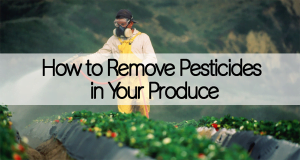The US department of agriculture conducted a survey recently in which they tested many produce, the results were shocking: they found pesticides in 65% of them Pesticides are everywhere. They can lower the intellectual availabilities of developing minds.
Even if your produce looks healthy, clean and fresh, it doesn’t mean that is 100% toxic free from the pesticides used to protect crop growth. That is why you should always look and buy organic alternatives to any food.
The top offenders for heavy pesticide residue are apples, celery, sweet bell peppers, potatoes, nectarines, strawberries, grapes, spinach, cherry tomatoes and snap peas.
The most endangered one is the nectarines because 99% of the sampled group show at least one pesticide residue.
But there is something positive, there are also fruits and vegetables that rank low on pesticide residue presence. The main ones amongst them are avocadoes, having a score of a wonderful 1% of detection in its sample group, which only proves once again that avocados are great for your health.
The cleanest produce you can find are eggplants, kiwis, yams, onions, sweet corn, papayas, pineapples, mangoes and cabbage. You can easily enjoy these products.
But what if you are craving for a juicy Fuji apple, what can you do?
You can find a variety of vegetable cleaners in most of the supermarkets. However, it is super simple to make your own vegetable cleaner, and it only requires one common household ingredient: white vinegar.
If you are one of those people that like knowing every little detail of what goes into your produce, you will normally choose the homemade vegetable cleaner.
Homemade Vegetable Cleaner
This recipe for a homemade vegetable cleaner is very simple: its 10% white vinegar and 90% water. It is recommended that you mix it in a large basin so you have enough room to properly soak your vegetables and fruits.
Leave your produce soaked in the mix for approximately 20 minutes. After 20 minutes, rinse your produce with fresh cold water.
If you have any fragile fruits like blueberries. It is not recommend to leave them in the mixture for the full 20 minutes, because the homemade vinegar mix can overwhelm their natural taste and blueberries are known to have porous skin.
You can always use lemon water to help eliminate the stench, if you do find a remaining vinegar smell on your fruits and vegetables.
At the end of the procedure you will find a strange gunky residue at the bottom of your basin. You might be guessing, that is pesticide residue that was hidden in your produce.
If you are don’t like the smell of vinegar and you don’t want to use it, don’t worry, because there is an alternative. According to the Center for Science and the Environment, you can eliminate pesticides from your produce with 2% salt water.
If you are using these methods correctly, you are likely to reduce the pesticide residue by 70%. Remember that there will always be some residue hiding in the folds and crevices that are too hard to be removed manually.
Taking your time to clean and prepare your food has huge health benefits for your family. Every step, from eliminating pesticides to incorporating organic produce, gradually brings you closer to achieving the necessary nutrition and keep your body at optimal performance.
Source : www.healthy-holistic-living.com





